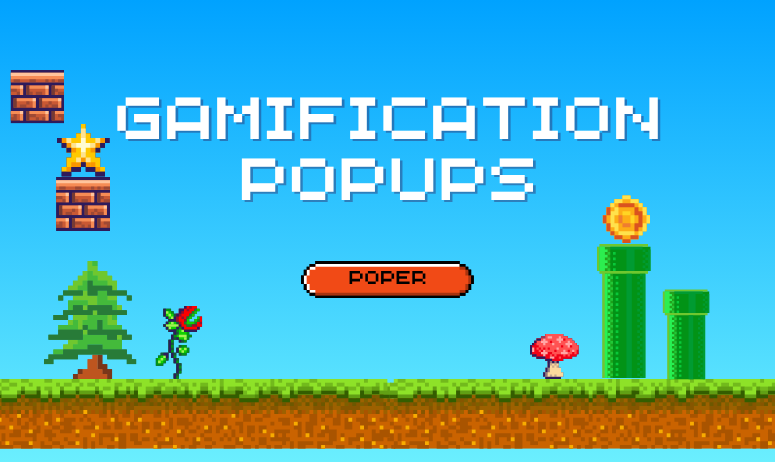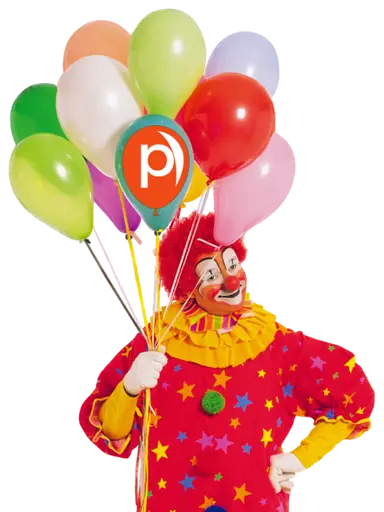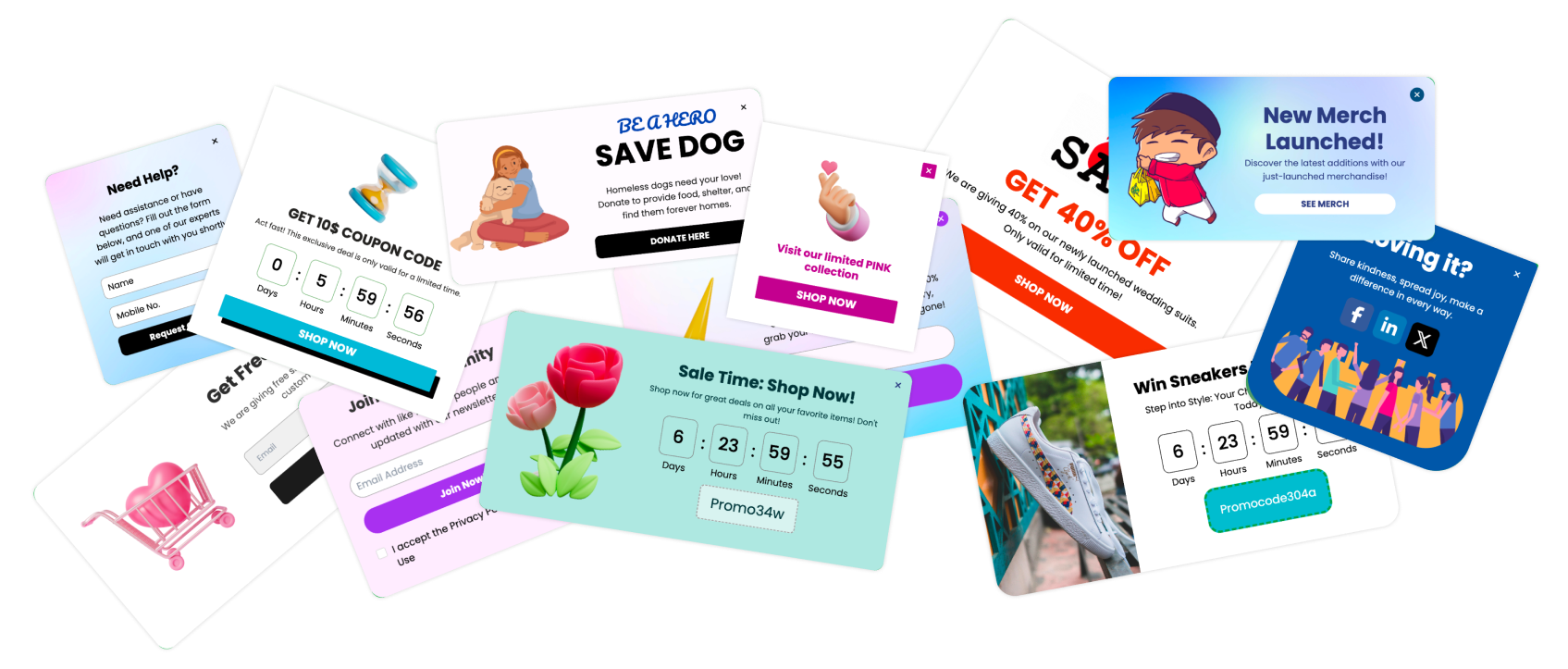What Are Game Popups?
Game popups are interactive on-site elements that use mini-games—like spin wheels, quizzes, or memory matches—to capture user attention, boost engagement, and drive conversions. Unlike standard popups that display static messages or forms, game popups make interaction fun, rewarding, and memorable, turning visitors into active participants rather than passive viewers.
Definition of a Game Popup and How It Differs from a Standard Popup
A game popup is an interactive popup that integrates simple gaming mechanics directly within a website. Think of it as a playful moment that appears during a user’s browsing experience — instead of just showing a “Sign up” or “Get 10% off” message, it lets the visitor earn that reward through a game.
Difference at a glance:
| Feature | Standard Popup | Game Popup |
|---|---|---|
| Purpose | Capture attention briefly | Engage users through interaction |
| User Experience | Passive (view or close) | Active (play and participate) |
| Emotional Response | Informational | Exciting and rewarding |
| Conversion Trigger | Text or form | Game-based action (win/reward) |
| Memory Recall | Low | High (fun and emotional connection) |
This shift from “showing” to “playing” changes how users interact with your brand — they remember the experience, not just the message.
Why Gamified Interactions Capture Attention and Drive Engagement
Humans are naturally drawn to play and reward. When you gamify a popup, you tap into powerful psychological triggers — curiosity, competition, and instant gratification.
Curiosity makes users wonder what they might win.
Challenge gives them a sense of purpose.
Reward releases dopamine, creating positive brand association.
Why Brands Use Game Popups
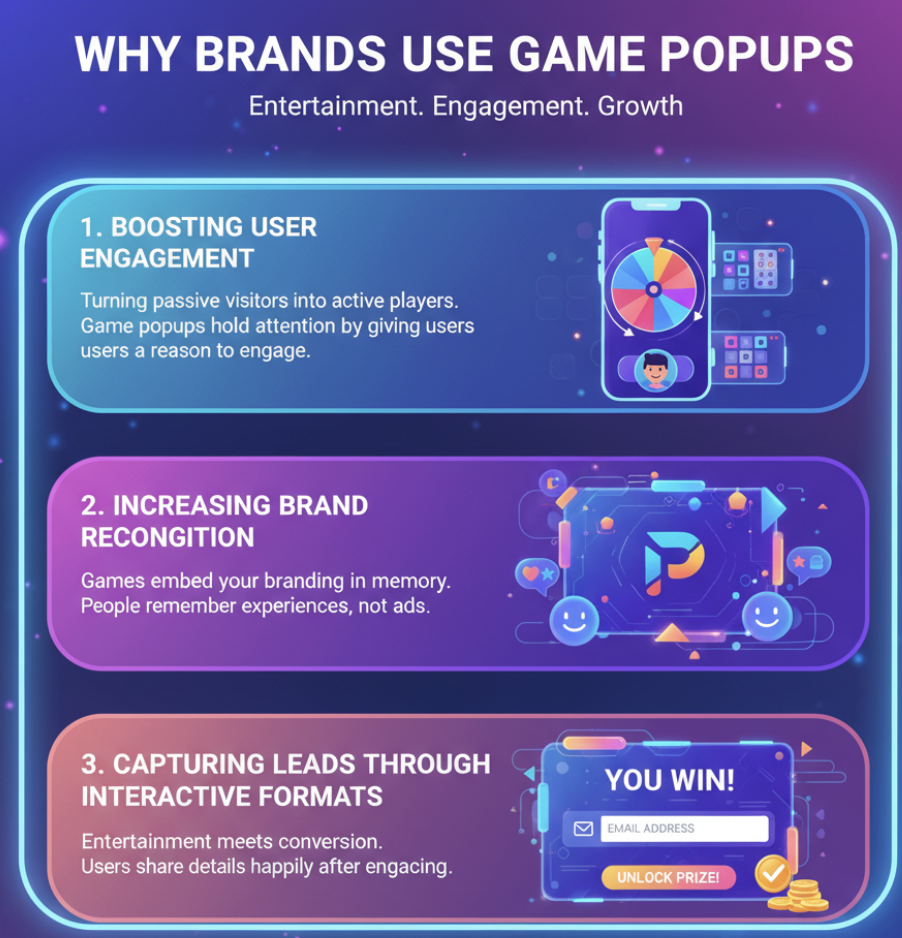
Boosting User Engagement – Turning Passive Visitors into Active Players
Most website visitors spend only a few seconds deciding whether to stay or leave. Traditional popups may grab attention for a moment, but game popups hold attention by offering something more compelling — a reason to interact.
When a user spins a wheel, plays a memory match, or answers a quick quiz, they’re not just engaging with a popup — they’re engaging with your brand.
Increasing Brand Recognition – Games Embed Your Branding in Memory
It’s a proven fact — people remember experiences, not ads.
By incorporating brand colors, logos, sounds, and messaging within a mini-game, users subconsciously associate positive feelings with your brand. Every play, animation, or reward builds familiarity and emotional connection.
Capturing Leads Through Interactive Formats – Collecting Emails or Data After Gameplay
The smartest brands know that engagement without conversion is only half the story.
Game popups merge entertainment with intent — users play, win, and then submit their details to claim the prize. This creates a voluntary data exchange, where visitors happily share their information because they’ve already received value.
For instance:
| Game Type | Reward Offered | Data Captured |
|---|---|---|
| Spin-to-Win | Discount code | |
| Memory Match | Free trial or ebook | Name + Email |
| Quiz | Personalized results | Email + Preferences |
Standing Out from Competition with Unique Onsite Experiences
In a sea of popups, game popups make you memorable.
While most websites rely on static forms or repetitive discount boxes, gamified popups introduce delight, anticipation, and interaction. They don’t interrupt the user journey — they enhance it.
A visitor who enjoys playing your “Spin & Win” game or quiz popup will likely:
Stay longer on your site
Remember your brand more vividly
Share the experience with others
5 Types of Game Popups You Can Create
“The best marketing doesn’t feel like marketing — it feels like play.”
Gamified popups aren’t limited to one style or mechanic. Depending on your goals — whether to increase engagement, collect leads, or simply make your site more memorable — there’s a perfect game type for every use case. Below are the most popular formats you can build using Poper’s no-code gamification builder.
Classic Arcade-Style Games (Flappy Bird, Memory Match)
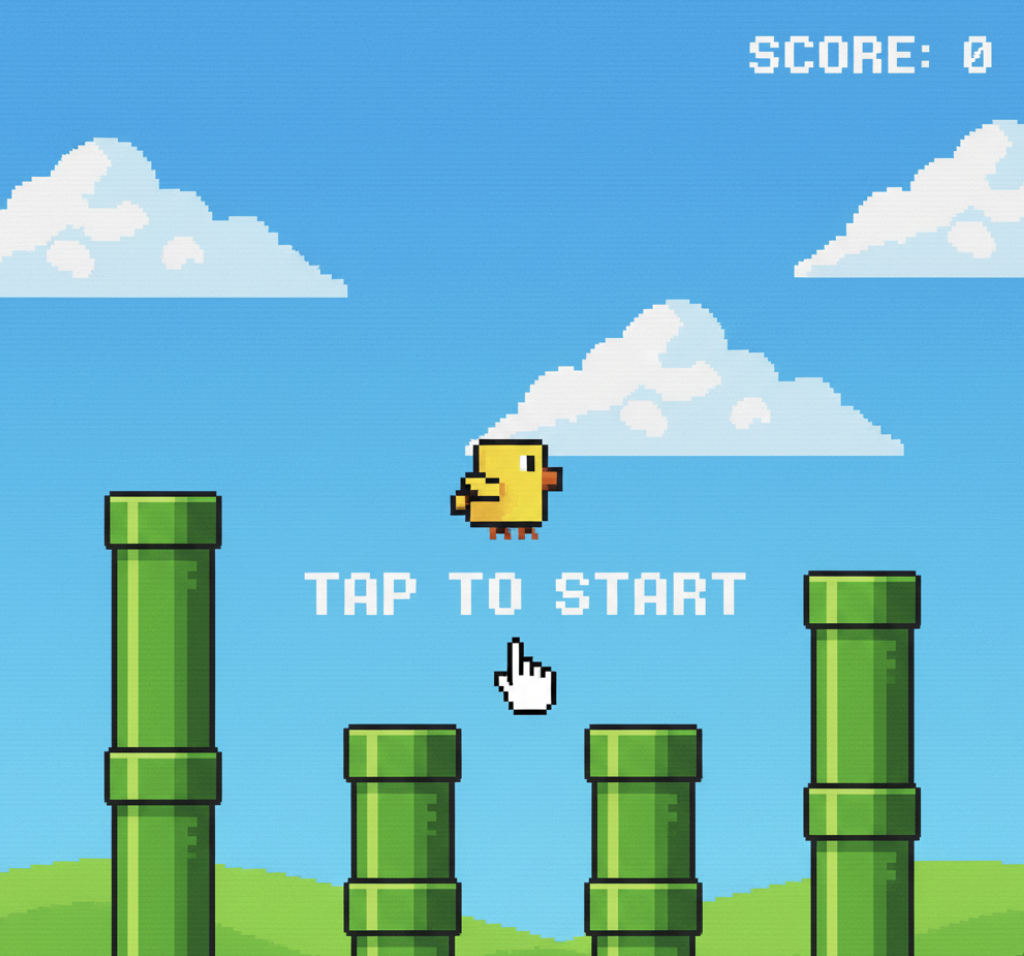
Arcade-style popups bring nostalgia and excitement together. Inspired by classics like Flappy Bird, Memory Match, or Fruit Ninja, these popups instantly trigger familiarity and fun.
Users enjoy a quick, skill-based experience — flying through obstacles, matching icons, or slicing fruits — and receive rewards based on their performance.
Why it works:
Highly engaging and instantly recognizable
Increases dwell time by making users play longer
Encourages repeat visits to beat previous scores
Best for: Engagement campaigns, loyalty challenges, or gamified content promotions.
Spin-to-Win Wheels and Prize Games
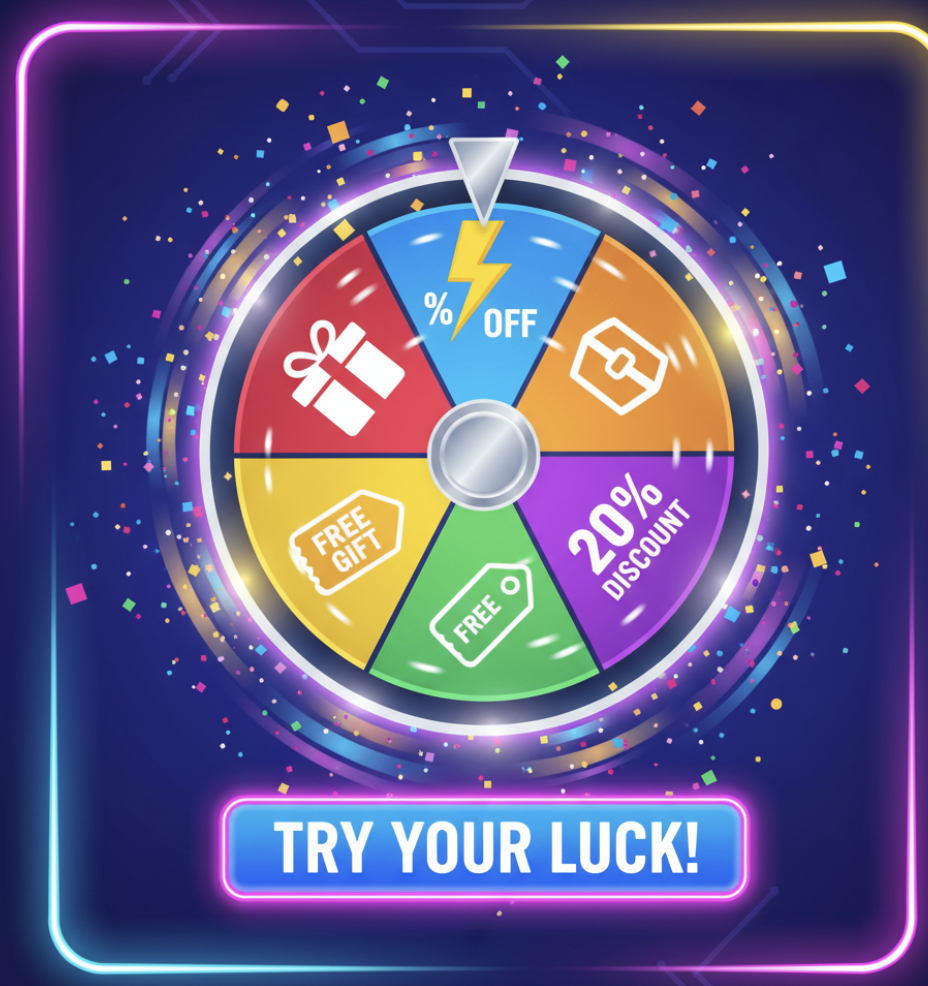
The Spin-to-Win format is one of the most popular game popups online. It combines suspense, reward, and luck in one satisfying spin.
Users spin a digital wheel to win discounts, freebies, or exclusive perks. The dopamine rush from seeing the wheel stop creates instant emotional engagement.
Why it works:
Simple and universally understood mechanic
Triggers curiosity and excitement instantly
Collects leads right after the spin for reward delivery
| Wheel Section | Example Reward | Probability |
|---|---|---|
| 10% Off | Small discount | 40% |
| Free Shipping | Medium reward | 25% |
| Free Product | Top-tier reward | 5% |
Quiz and Trivia Popups
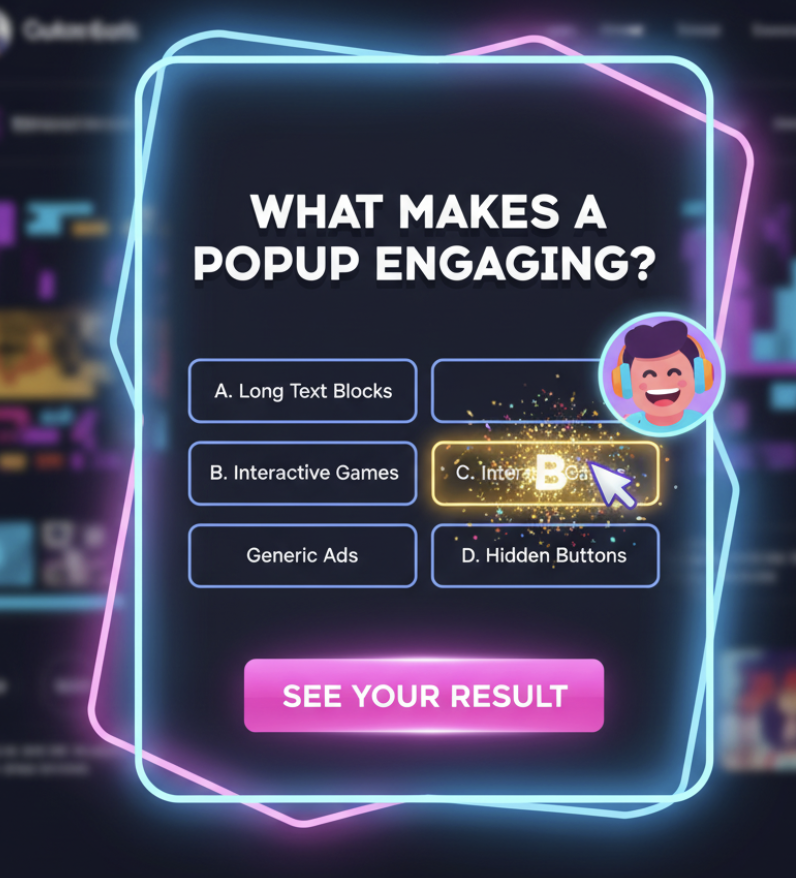
Quiz popups test users’ knowledge while subtly educating them about your product or niche. A skincare brand might ask, “What’s your skin type?” while a SaaS company might quiz visitors on productivity tools.
At the end of the quiz, users receive a personalized result or reward, making the interaction feel intelligent and tailored.
Why it works:
Creates a sense of personalization and relevance
Helps segment leads based on responses
Builds trust through interactive learning
Puzzle or Matching-Game Popups
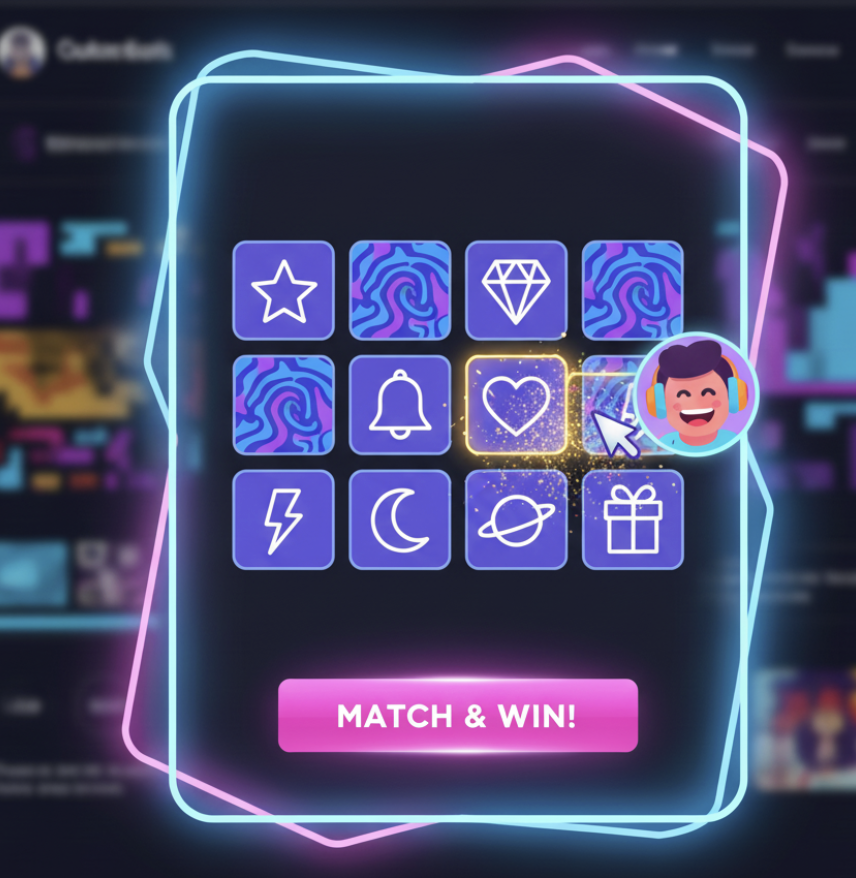
Puzzles trigger curiosity and patience — two traits that keep users engaged longer. From drag-and-drop tile puzzles to icon matches, they challenge the mind and create a rewarding “aha!” moment when solved.
Why it works:
Encourages active participation and focus
Builds cognitive connection with the brand
Creates a memorable, skill-based experience
Ideal for: Awareness campaigns, product reveals, or team-building microsites.
Scratch Cards, Slots, or Chance-Based Games
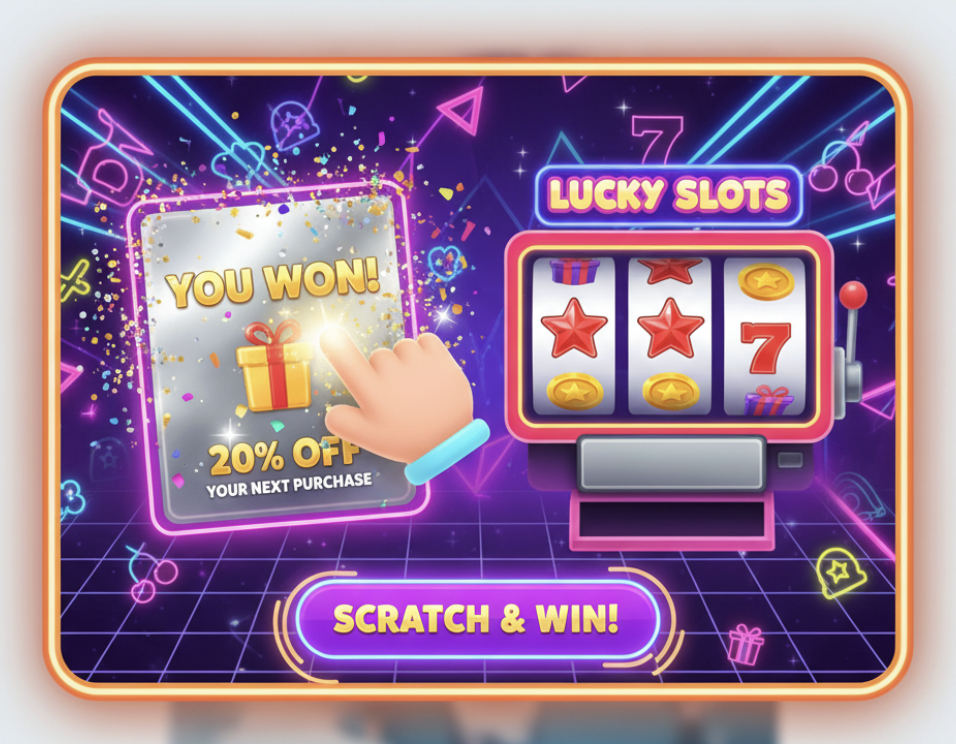
If you’ve ever scratched a lottery card or pulled a slot lever, you know the thrill of uncertainty. These game popups replicate that excitement digitally.
Users scratch an area or click to reveal a prize — from coupons to exclusive content. The moment of surprise keeps users emotionally engaged until the end.
Why it works:
High anticipation and instant gratification
Works perfectly for promotions and flash sales
Drives immediate conversions with visible rewards
Core Components of an Effective Game Popup
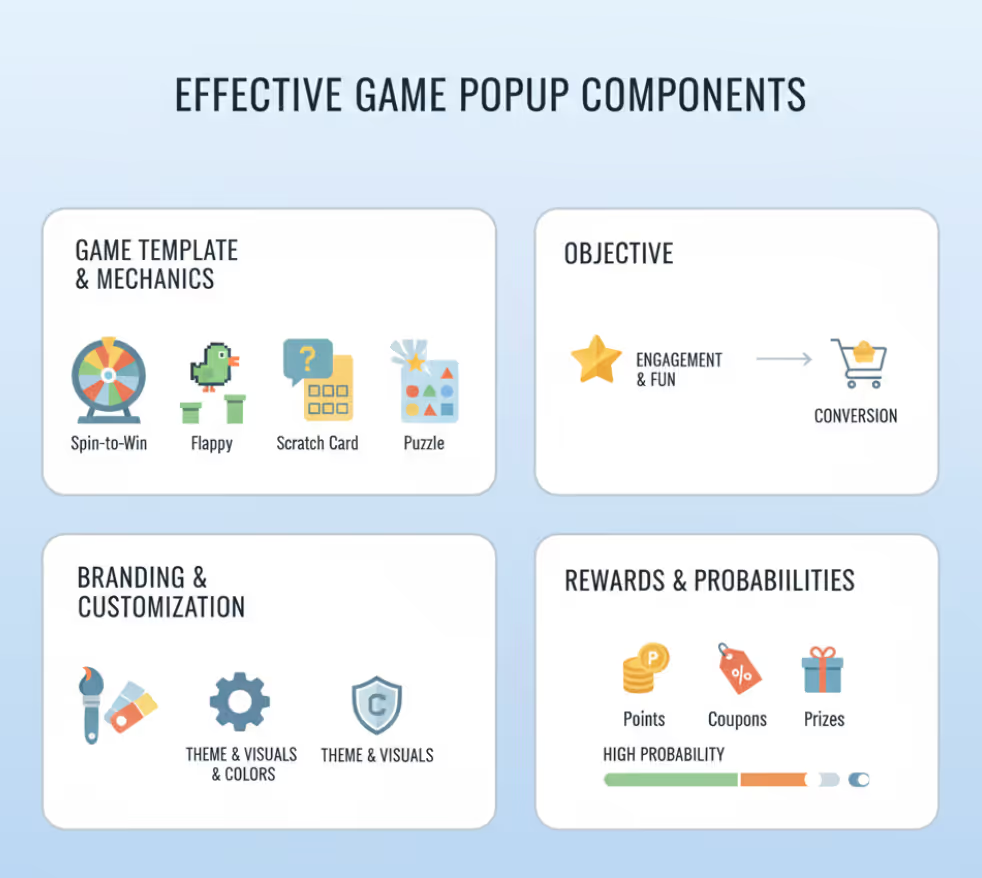
Game popups may look playful on the surface, but behind every successful one lies a carefully designed structure. To create an engaging, high-performing experience, every component — from the visuals to the logic — must work harmoniously.
Game Template and Mechanics – Choosing the Right Format from 100+ Templates
The foundation of any game popup starts with the right template and mechanics. Whether you choose a spin wheel, memory match, or quiz, your game’s success depends on how well the mechanic aligns with your campaign’s goal.
| Objective | Best Game Type | Example |
|---|---|---|
| Collect emails | Spin-to-Win | Spin and win a discount |
| Educate audience | Quiz Popup | Answer questions and get personalized results |
| Increase dwell time | Arcade Game | Play Flappy Bird and win points |
| Boost conversions | Scratch Card | Reveal instant coupons |
Branding and Customization – Embedding Logos, Colors, and Visual Style
A game popup should feel like your brand, not a random third-party widget.
That’s why branding is crucial. Your logo, color palette, and tone must stay consistent with your website identity. This ensures that even when users play, they subconsciously reinforce brand recall.
With Poper, you can:
Add your own logo and background images
Customize fonts, colors, and animations
Apply brand-specific reward visuals (like your own coupon designs)
When the game looks and feels like your brand, users perceive it as a seamless part of your website experience.
Rewards & Probabilities – Defining Prize Logic and Win Chances
The secret sauce of gamified engagement lies in how you design rewards. Users play because they expect a payoff — even if it’s small. That’s where reward logic and probability control come in.
With Poper, you can:
Assign specific probabilities to each prize
Decide how often users can win (e.g., 10% chance for a free plan)
Limit plays per user or per session
Automate reward delivery via email or on-screen message
Example Setup:
| Reward | Probability | Limit |
|---|---|---|
| 20% Off Coupon | 50% | Unlimited |
| Free 7-Day Trial | 30% | 200 users/month |
| Free Plan Upgrade | 10% | 50 users/month |
| Grand Prize | 1% | 10 users/month |
Data Capture and CTAs – Collecting Contact Information While Providing Value
The goal of most gamified popups is not just to entertain — it’s to convert.
Once users finish playing, that’s your perfect window to capture leads. Instead of showing a generic form, use context:
“Congrats, you’ve unlocked 15% off! Enter your email to claim it.”
This creates a natural value exchange where users feel rewarded, not pressured.
Mobile and Responsive Design – Ensuring Seamless Experience Across Devices
Over 70% of web traffic comes from mobile devices — and yet, many popups still fail to deliver smooth experiences on smaller screens.
Your game popup should adapt perfectly across all devices: desktop, tablet, and mobile. Lag, broken layouts, or small touch targets can kill engagement instantly.
Designing the Player Journey
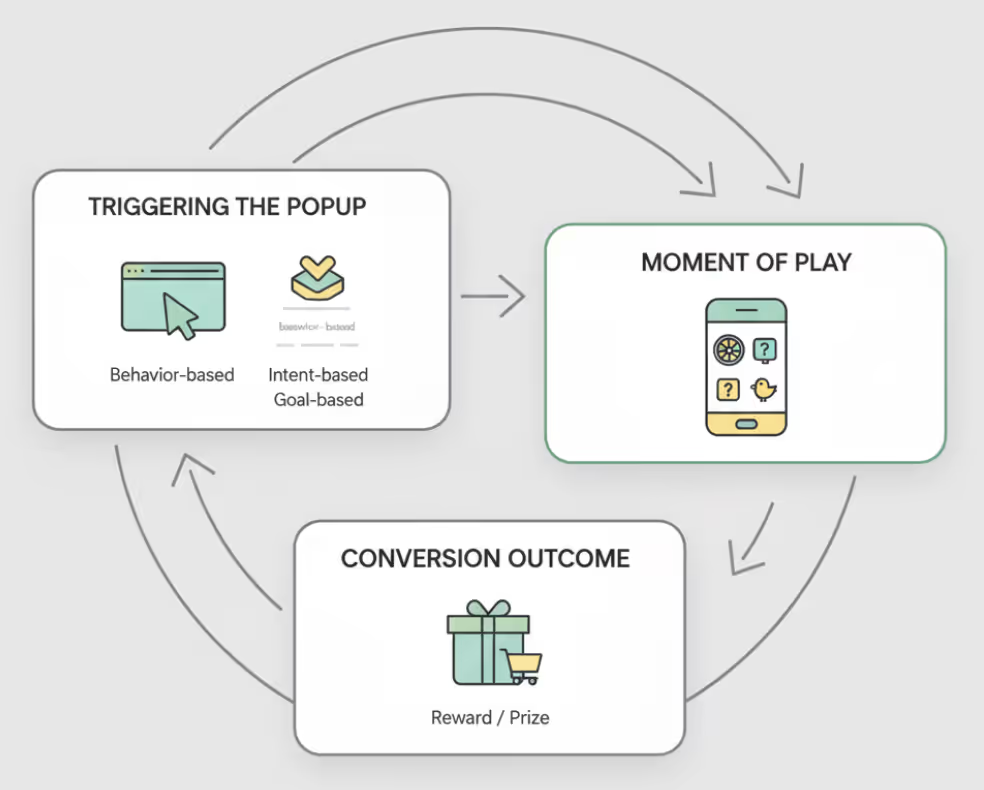
A game popup isn’t just about what users play — it’s about how they experience it from start to finish. Designing an effective player journey ensures users don’t just have fun, but also follow through to the action your brand wants them to take.
Think of it like a mini-story: there’s an entry point, a moment of play, and a conversion outcome. Each stage needs thoughtful design and timing.
Triggering the Popup: Timing, User Intent, and Behavior
The first step in the journey is when and why the game popup appears. Poorly timed popups can frustrate visitors, while context-aware ones feel natural and inviting.
Best practices:
Behavior-based triggers: Show the popup after a specific action (like scrolling 60% of a page).
Intent-based triggers: Detect exit intent or idle time before displaying it.
Goal-based triggers: Use game popups during product launches or promotions to drive conversions.
Entry vs Exit vs Scroll Triggers
Not all triggers are created equal — each serves a unique purpose:
| Trigger Type | Ideal Use Case | Example |
|---|---|---|
| Entry Trigger | Brand awareness | Welcome visitors with a “Play & Win” popup |
| Scroll Trigger | Mid-funnel engagement | Show a quiz or memory game after users explore content |
| Exit Trigger | Conversion recovery | Offer a game with a discount when users intend to leave |
Onboarding the Game: Immediate Clarity on Rules and Rewards
Once the popup appears, clarity is everything. If users don’t understand what to do, they’ll close it instantly.
Your onboarding message should:
Clearly explain what the game is about (“Play to win a discount!”)
Tell users what’s at stake (“You could win up to 50% off”)
Keep instructions minimal (one short line or icons work best)
Post-Game Action: Lead Capture or Conversion Step
The post-game moment is where fun meets function. After gameplay ends, users are in a high-engagement state — that’s when you guide them toward your conversion goal.
This can include:
Lead Capture Form: “Enter your email to claim your prize.”
Coupon Reveal: “Here’s your 20% off code — apply it at checkout.”
Call-to-Action Button: “Start your free trial now.”
By aligning rewards with your business goals, you turn gameplay into tangible outcomes.
Integrating Game Popups Into Your Marketing Funnel
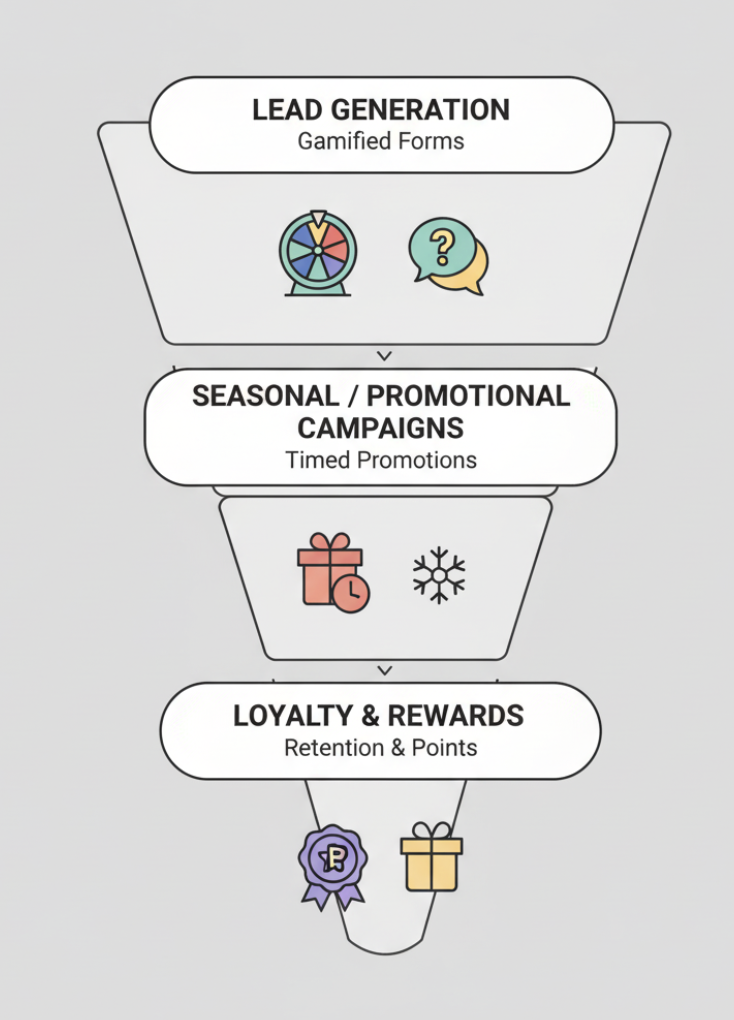
Using Game Popups for Lead Generation Campaigns
Lead generation is the most common use of game popups. Instead of a boring form, gamify the experience: users spin, scratch, or answer a quiz to unlock a reward, creating a positive exchange.
Benefits:
Higher form submission rates because the user feels rewarded
Segmentation of leads based on game choices or quiz answers
Data capture that feels natural and engaging
Incorporating Them into Seasonal or Promotional Strategies
Game popups shine during limited-time offers, holidays, or special events. For example:
A Halloween-themed memory match game could reveal a spooky discount.
A Black Friday spin wheel could give tiered rewards based on luck.
Why it works: Users are already primed for seasonal excitement, and gamified interactions increase urgency and participation, turning festive marketing into measurable conversions.
Loyalty and Reward Programs via Gamified Popups
Beyond single-visit conversions, game popups are excellent for retention and loyalty programs. Reward returning visitors with games that unlock points, exclusive content, or discounts.
Benefits:
Reinforces brand affinity
Encourages repeat visits
Builds a community of engaged users
Aligning Game Popups with Your Email Automation and CRM
Game popups don’t have to operate in isolation. When tied to email automation, they become an integrated part of your funnel:
Capture an email after gameplay
Trigger personalized email sequences based on user behavior or reward type
Nurture leads toward purchases or upgrades
By syncing with a CRM, you can track which game interactions lead to conversions and refine your marketing strategy accordingly.
How to Launch a Game Popup with Poper
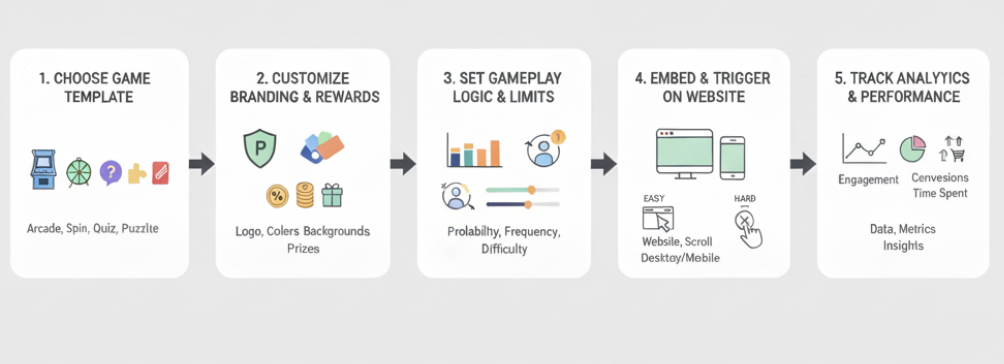
“The best game popup is the one that’s live before your audience even notices the setup.”
Overview of Poper’s Gamification Builder – No Coding Required (Poper)
The gamification builder is designed to help marketers and businesses:
Choose from 100+ ready-made game templates
Customize visuals, rewards, and game logic
Trigger popups based on user behavior or intent
Capture leads and connect to CRM/email tools
Track analytics and performance
Everything is drag-and-drop and visual, so you can focus on creativity and strategy instead of technical setup.
Choosing a Game Template and Customizing It
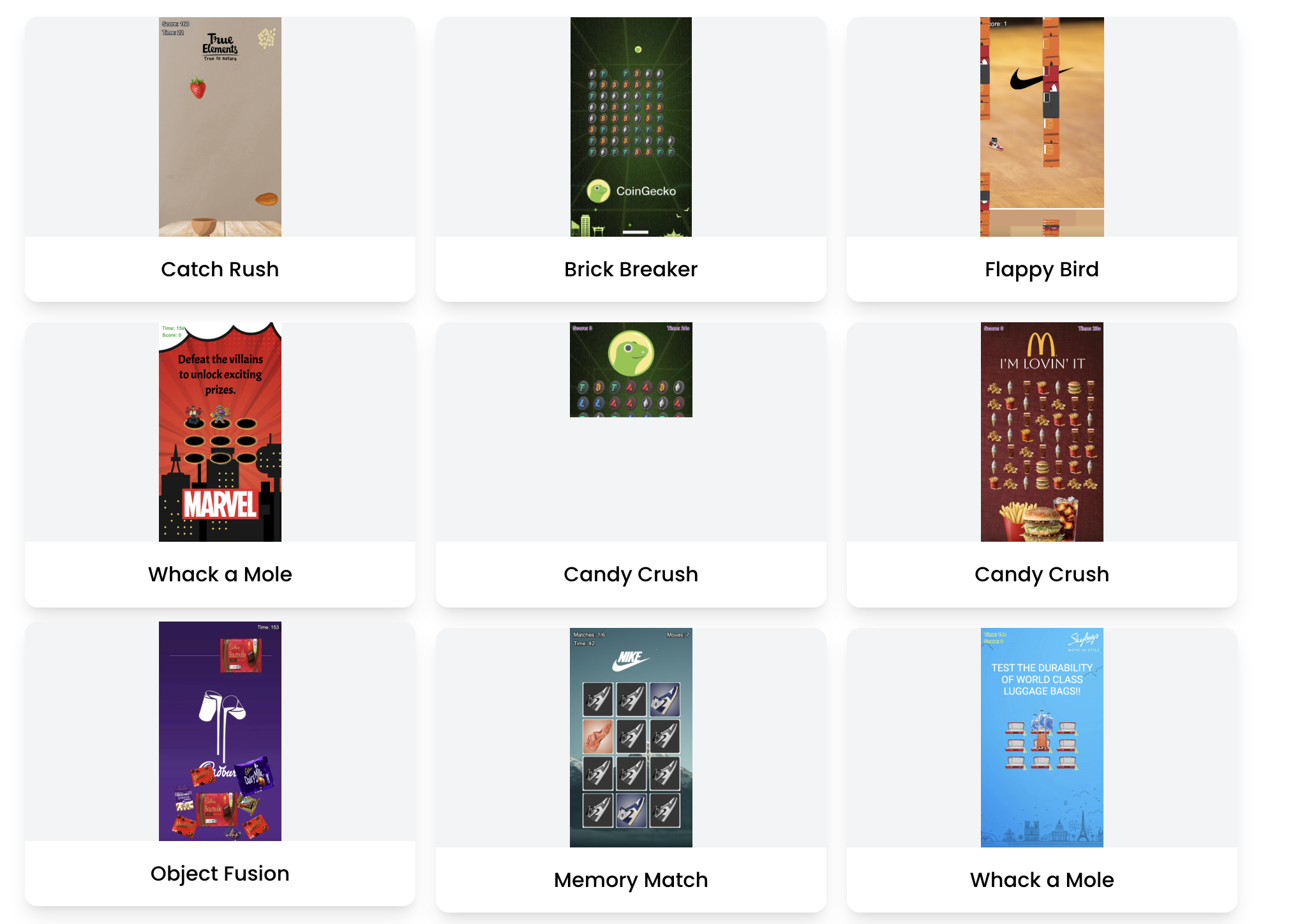
Start by selecting the game type that aligns with your campaign goal: arcade, spin wheel, quiz, puzzle, or scratch card. Then:
Add branding elements (logo, colors, background)
Customize gameplay mechanics (difficulty, chances of winning)
Decide reward types (discounts, free trials, points, or gifts)
Setting Up Branding, Rewards, and User-Play Limits
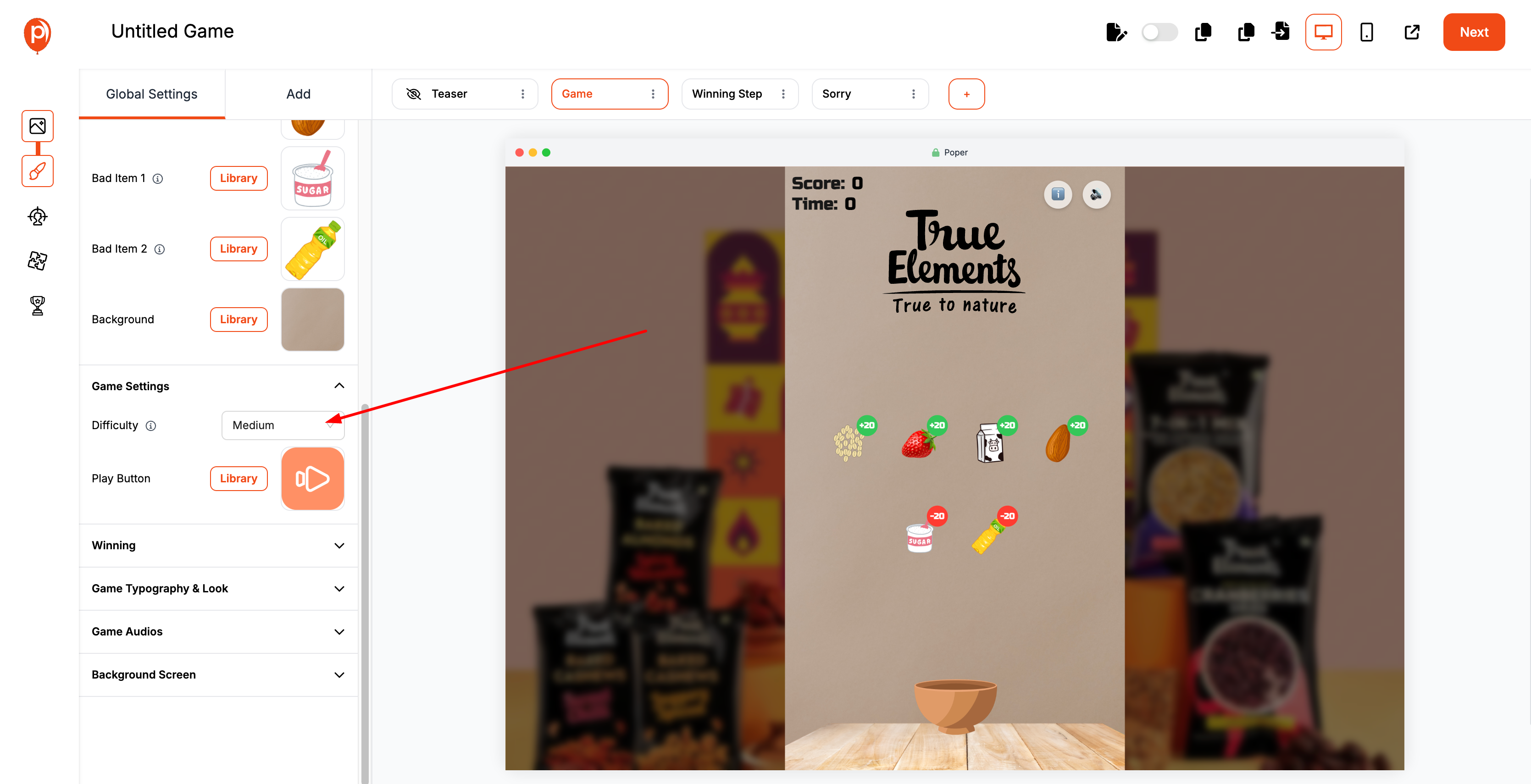
Once the design is ready:
Set win probabilities for each reward to balance excitement and business goals
Decide frequency limits to prevent abuse (e.g., one spin per user per day)
Personalize reward delivery, such as showing codes directly after gameplay or emailing winners
This ensures every interaction feels fair, motivating, and aligned with your marketing objectives.
Adding the Game on Your Website and Firing the Trigger
After setup, it’s time to go live:
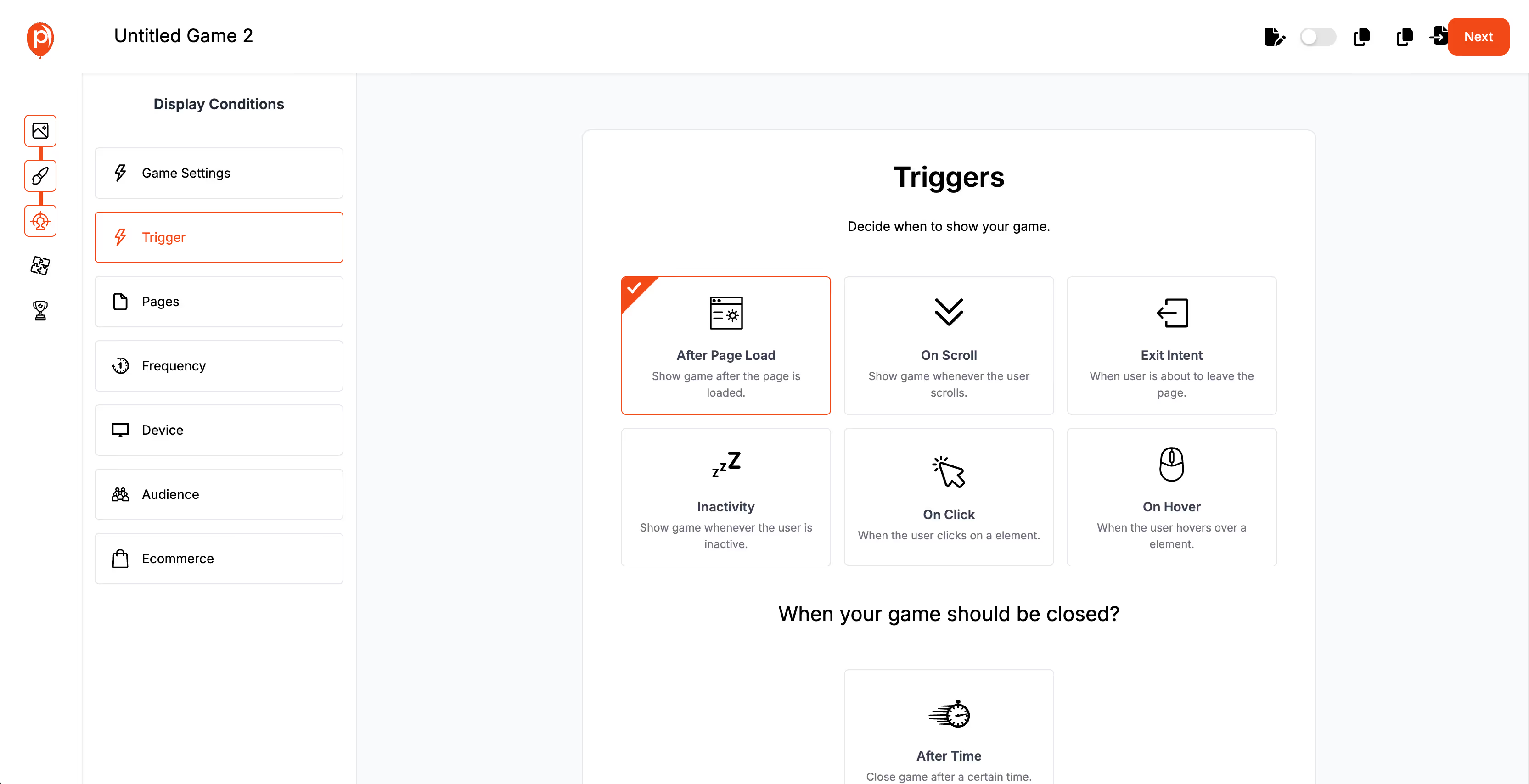
Configure triggers like entry, scroll, or exit intent
Preview on desktop and mobile to ensure perfect responsiveness
The result: a fully interactive game popup ready to capture attention the moment visitors arrive.
Tracking Analytics and Performance Inside Poper’s Platform
The final step is measurement and optimization. Poper provides real-time analytics for:
Number of plays and completion rates
Lead submissions and email captures
Conversion rates for rewards and offers
User engagement patterns, including mobile vs desktop behavior
By analyzing these metrics, you can refine game logic, tweak rewards, and optimize triggers to continuously improve engagement and conversions.
Best Practices & Mistakes to Avoid
To get the most from game popups, keep mechanics simple, be transparent with rewards, ensure mobile optimization, guide users to post-game actions, and continuously test different versions. Avoid over-complexity, misleading offers, and ignoring analytics.
Keep Mechanics Simple and Intuitive – Avoid Over-Complexity
Users don’t want to read long instructions or figure out complicated rules. The simpler the game, the higher the participation.
Focus on one clear objective per popup.
Use familiar game types like spin wheels, quizzes, or memory matches.
Keep instructions short — icons, visuals, or one-line directions work best.
Be Transparent with Rewards and Rules – Build Trust
Nothing kills engagement faster than unclear prizes or hidden conditions.
Clearly show what the user can win.
Be honest about win probabilities.
Avoid “fake” or misleading rewards.
Transparency builds trust and encourages users to return for future interactions.
Ensure Excellent Mobile Performance – Game Popups Must Work Everywhere
With the majority of web traffic coming from mobile devices, game popups must look and feel great on any screen size.
Test games on multiple devices before launch.
Make touch interactions intuitive.
Avoid slow-loading animations or heavy graphics.
Don’t Forget the Post-Game Step – Conversion Must Follow Gameplay
Gameplay is only the beginning — the ultimate goal is conversion.
Capture leads immediately after the game.
Deliver rewards instantly.
Include a strong call-to-action (CTA) that aligns with your business goals.
Without a clear post-game step, your efforts may generate fun but not results.
Test & Iterate – Use A/B Testing to Find What Works Best
Not every game or trigger will perform the same for every audience. Continuous testing helps:
Identify which game types drive the most conversions.
Optimize triggers (scroll, exit, or timed).
Refine reward logic and messaging.
Measuring Success of Game Popups
Key Metrics: Plays, Conversions, Dwell Time, Lead Submissions
These metrics give a clear picture of performance:
| Metric | Why It Matters |
|---|---|
| Plays | Shows how many users engage with your game popup |
| Conversions | Measures success of lead capture or reward redemption |
| Dwell Time | Indicates user interest and interaction depth |
| Lead Submissions | Directly tracks captured emails or other user data |
Monitoring these metrics allows you to correlate engagement with actual results and make informed decisions about future campaigns.
Using Heatmaps & Behavioral Analytics for Optimization
Heatmaps and session recordings reveal how users interact with your popup:
Where do users click most?
Do they abandon the game mid-way?
Are mobile users struggling with certain interactions?
Analyzing this data helps refine game layout, controls, and trigger placement for a smoother experience.
Attribution: Linking Gameplay to Actual Business Outcomes
It’s essential to connect engagement to real results:
Did the user who played the game also convert into a paying customer?
Did the captured email open your promotional emails?
Which game type produces the highest ROI?
Attribution tracking ensures your gamification strategy aligns with revenue goals, not just engagement metrics.
Continuous Optimization: Refine Reward Logic and Interface
Game popups are dynamic, not static. Continuous optimization helps maximize impact:
Adjust reward probabilities to balance excitement and profitability.
Experiment with different game types for your audience.
Refine visuals, CTAs, and instructions based on analytics.
Compliance, Trust & User Experience
Game popups must respect user privacy, ensure fairness, and be accessible to all. Compliance with GDPR/CCPA, clear reward logic, and inclusive design make your gamified experiences trustworthy and enjoyable, while building long-term customer relationships.
Respect User Data: GDPR/CCPA Compliance in Gamified Interactions
Whenever you collect emails, names, or other personal data, you must adhere to privacy regulations:
Display consent forms for email collection.
Provide an option to opt-out at any time.
Ensure collected data is securely stored and processed.
Manage Play Limits and Fairness – Avoid Addictive or Manipulative Patterns
Games should reward users fairly and avoid exploitative practices.
Set play limits per user or session to prevent abuse.
Be transparent about win probabilities and reward rules.
Avoid creating addictive loops that frustrate users.
Fair gameplay encourages repeat visits and builds long-term trust with your audience.
Accessibility and Inclusive Design – Games Should Be Playable by All Users
Inclusive design ensures everyone can participate, including users with disabilities:
Use keyboard and screen reader-friendly controls.
Avoid relying solely on color or visual cues for instructions.
Test your game on different devices, browsers, and assistive technologies.
Inclusive gamification not only broadens your audience but also strengthens your brand reputation.
Summary
Game popups are a powerful tool for modern marketers, turning passive visitors into active participants. By leveraging fun, interactive, and rewarding experiences, brands can increase engagement, boost leads, and drive conversions.
Key takeaways:
Types of game popups: Arcade-style, spin wheels, quizzes, puzzles, scratch cards, and slots.
Core components: Game mechanics, branding, rewards, data capture, and responsive design.
Player journey: Thoughtful triggers, clear instructions, and post-game conversion steps.
Marketing integration: Lead generation, seasonal campaigns, loyalty programs, and email automation.
Best practices: Keep it simple, transparent, mobile-optimized, and test continuously.
Measurement: Track plays, conversions, dwell time, and leads; use heatmaps and attribution.
Compliance: Respect privacy, ensure fairness, and design inclusively.
Future trends: AI personalization, cross-channel gamification, AR/VR, and blockchain rewards.
FAQs
What kinds of games can I build with Poper?
You can create over 100 templates inspired by classics like Flappy Bird, Memory Match, Candy Crush, slots, and more.
Do I need coding skills to use Poper’s gamification builder?
Not at all. It’s fully no-code and intuitive, designed for marketers and business owners.
Can I fully brand the game with my assets?
Yes. Upload your logo, colors, and media to make the game feel entirely like your brand.
How do I set the odds and reward logic?
Poper lets you configure probabilities and reward rules directly within the editor, balancing excitement and fairness.
Are game popups mobile-friendly?
Absolutely. All templates are responsive, ensuring a seamless experience across desktop, tablet, and mobile devices.


